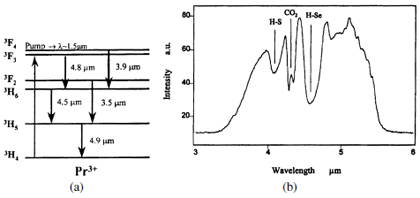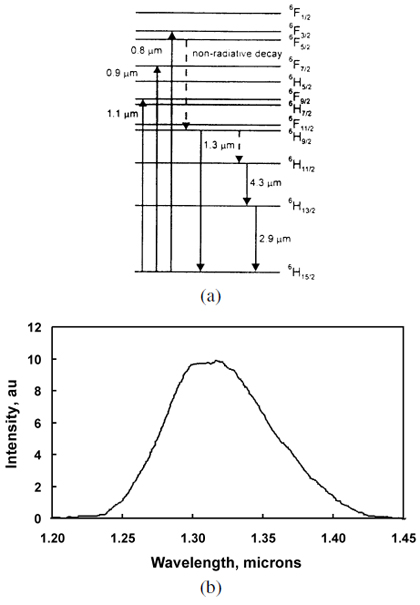Optipedia • SPIE Press books opened for your reference.
Chalcogenide glass optical fiber amplifiers
Excerpt from Infrared Fibers and Their Applications
The chalcogenide glass fibers are also a potentially excellent host for RE ions, not only for the 1300- and 1550-nm telecommunication systems, but also for applications at the longer wavelengths. The chalcogenides have particularly low phonon frequencies and, therefore, they are potentially attractive hosts for laser transitions in the near- and middle-IR region.1 That is, transitions that would be quenched by the high-frequency phonons in oxide and fluoride glasses are possible in these hosts. Some of the same RE ions have been doped into the chalcogenide glasses that have been used for the HMFGs. For example, Nd3+-doped sulfide-glass fibers have lased at 1.08 µm, while both Nd3+- and Pr3+-doped sulfide fibers have been used as amplifiers at 1.08 and 1.34 µm, respectively. One of the exciting aspects for these host glasses is the possibility of lasing from transitions at long wavelengths. Pr3+, for example, has emission bands at 1.3, 1.6, 2.9, 3.4, 4.5, 4.8, 4.9, and 7.2 µm.1
The discussion in Sec. 10.2 pertaining to OFAs operating at 1300 nm focused on Pr3+-doped fluoride glass fibers. This fiber system, however, has a poor quantum efficiency (3% to 5%) and a small absorption cross section. If Pr ions are instead added to chalcogenides with their lower phonon frequencies, as low as 350 cm-1 for selenides compared to ~500 cm-1 for fluorides, then the efficiency is expected to be better. Additionally, Dy3+ ions are a good choice for 1300-nm applications, especially in selenide glasses, where efficiencies approaching 90% can be realized due to the low phonon energy of the selenide glass.
Cole et al.2 have studied Pr3+ ions doped into GeAsGaSe glass fibers. Their work on Pr3+ doping de-emphasized the 1300-nm band in favor of the longerwavelength emission bands in the 3- to 5-µm region. Pr3+ has two strong absorption bands at 1.5 and 2.0 µm for pumping into this region. The energy-level diagram for Pr3+ ions is given in Fig. 10.7(a) and the mid-IR emission from a GeAsGaSe MM fiber is shown in Fig. 10.7(b).2 In Fig. 10.7(b) it can be seen that there is a reduction in the emission at ~4.1 and ~4.5 µm due to the strong absorption of S-H and Se-H impurities, respectively. These absorption bands are also shown in Figs. 5.10 and 5.11, for the sulfide and selenide glasses. Clearly, a reduction in these hydrogen-bonded impurities would be necessary for any active device operating most efficiently across this broad emission region.

Figure 10.7 (a) Energy-level diagram for Pr3+ in chalcogenide glass host. (b) Emission spectrum for Pr3+ in selenide glass fiber. [Reprinted from Ref. 2, Copyright 1999, with permission from Elsevier.]
Dy3+, Pr3+, and Tb3+ ions have been studied in chalcogenide host glasses for OFAs at 1300 nm.3-8 Adding Pr3+ to GaLaS glass, for example, increases the quantum efficiency from a few percent in fluoride glass to about 30% in GaLaS glass.9 Recently, however, there has been more emphasis placed on Dy3+ ions in both the selenide and LaS glasses, as these glasses have low phonon frequencies.10 Specifically, the total quantum efficiency at 1300 nm for Dy3+ in either GaLaS or selenide glasses is at least 30%, or considerably higher than Pr3+ in fluoride glasses. Also, because of the large cross sections, i.e., the high absorption for these glasses, the length of the fiber needed is only about 1/10 of that needed for Pr-doped fluoride glass fibers. The energy-level diagram for Dy3+ is shown in Fig. 10.8(a) along with the fluorescence of Dy3+ in GaLaS glass pumped with 0.907-µm radiation in Fig. 10.8(b). It is interesting to note two things from the data in Fig. 10.8. First, the 6H9/2 -> 6H11/2 transition leading to 1300-nm emission would be entirely quenched for Dy3+ in fluoride glass hosts. Second, the emission peak shown in Fig. 10.8(b) is centered nearer the 1310-nm zero dispersion wavelength for standard telecommunications fibers than the same peak in Pr-doped fluoride or oxide glasses (compare to the data for Pr shown in Fig. 10.6). Dy3+ has also been doped into GeAsGaSe fibers by Cole et al.2 These researchers added 400 ppm Dy3+ into a core-only fiber. The measured losses were a respectable 0.8 dB/m at 6 µm and 1.5 dB/m at 1.5 µm. When a 4-µm-core SM fiber was drawn for the same composition, the losses were found to increase to 3 dB/m at 1.55 µm. These fibers have applications both at 1.3 µm and in the 3- to 5-µm band. Longer wavelength emission from 7 to 9 µm has been demonstrated in Tb-doped GeAs- GaSe and GeAsGaTe glasses.6 This represents the longest wavelength emission seen from any RE-doped glass or crystal system. The measured lifetime of the excited state was 12 µs and 80 µs for the selenide and telluride glasses, respectively. Recently, Churbanov et al.11 studied As-Se and As-S-Se glasses doped with Tb3+, Dy3+, and Pr3+. Their As-Se fibers had a loss of 1.5 dB/m in the 6- to 9-µm range.

Figure 10.8 (a) Energy-level diagram for Dy3+-doped gallium lanthanum sulfide (GLS) glass and (b) corresponding fluorescence spectrum of Dy3+-doped GLS glass pumped at 0.907 µm.10 [Reprinted with permission.]
References
- J. Sanghera, L. B. Shaw, L. Busse, V. Nguyen, P. Pureza, B. Cole, B. B. Harbison, and I. Aggarwal, "Development and infrared applications of chalcogenide glass optical fibers," Fiber and Integrated Optics, Vol. 19, pp. 251-274 (2000).
- T. Schweizer, F. Goutaland, E. Martins, D. W. Hewak, and W. S. Brocklesby, "Site-selective spectroscopy in dysprosium-doped chalcogenide glasses for 1.3 micron optical-fiber amplifiers," J. Opt. Soc. Am. B, Vol. 18, pp. 1436-1442 (2001).
- J. Heo and Y. B. Shin, "Absorption and mid-infrared emission spectroscopy of Dy3+ in Ge-As (or Ga)-S glasses," J. Non-Cryst. Solids, Vol. 196, pp. 162-167 (1996).
- L. B. Shaw, B. Cole, J. S. Thielen, J. Sanghera, and I. Aggarwal, "Mid-wave IR and long-wave IR laser potential of rare-earth doped chalcogenide glass fiber," IEEE J. Quantum Electron., Vol. 48, pp. 1127-1137 (2001).
- D. W. Hewak, B. N. Samson, J. A. Medeiros Neto, R. I. Laming, and D. N. Payne, "Emission at 1.3 microns from dysprosium-doped Ga:La:S glass," Electron. Lett., Vol. 30, pp. 968-970 (1994).
J. Harrington, Infrared Fibers and Their Applications, SPIE Press, Bellingham, WA (2003).
View SPIE terms of use.

